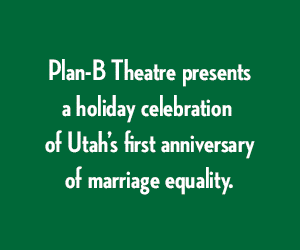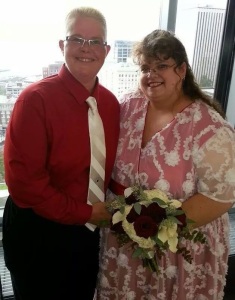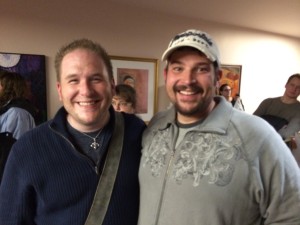NOTE:This is the second part of a preview featuring a pair of Plan-B Theatre holiday productions.
In 2013, during U.S. Supreme Court oral arguments for the landmark Windsor case on same-sex marriage, Chief Justice John Roberts remarked that activists had really found their political momentum. Writing the day after the hearing, The Atlantic’s Conor Friedersdorf remarked, “But as public opinion on divorce law and prevailing attitudes about straight marriage attest, [the ‘sincere traditionalists’ … who see marriage as a sacramental, procreative institution, rather than one grounded in love] is a tiny group of people — not nearly enough to constitute a majority that can block gay marriage. That requires the addition of the ‘yuck, gays’ vote, which is rapidly shrinking. It turns out that once Americans get to know gay people they find they rather like them.”

Likewise, The Chicago Sun-Times’ Neil Steinberg explained how the coming out experience also had fortified the movement and, indeed, had accelerated the pace of changing attitudes. He wrote, “They helped their families understand that religion and morality — the former always equating anything it does with the latter — are not always linked. The persecution of gay people — like all the insane hatreds of the past, from the slaughter of Native Americans to the enslavement of blacks to the subjugation of women — was never moral, as was claimed. It was, and is — and for a while yet, among a dwindling minority — a faith-cloaked sin, which wasn’t seen as such because they had the numbers.”
Within months of the Windsor decision, the momentum roared ferociously, suggesting with increasing confidence that marriage equality soon would come to every state. And, just five days before Christmas last year, in Utah, where the anti-marriage equality bedrock of ‘sincere traditionalists’ perhaps seemed most impenetrable, U.S. District Court Judge Robert Shelby ruled in favor of the plaintiffs in Kitchen v. Herbert. For 17 days until a stay on the decision was issued by U.S. Justice Sonia Sotomayor on Jan. 6, hundreds of Utah couples were married, an event that many of the state’s astute political observers had thought would have been unthinkable in terms of how rapidly Utah had moved to the column of states with marriage equality. In Utah, the 2013 holiday season’s normally placid news cycle had been transformed into an emotional drama with blistering passion that seemed only possible in fiction.

Journalism provides the initial rough draft of history. However, Plan-B Theatre’s Jerry Rapier already was thinking in early January about how this event’s second draft could be written. He turned to journalist-cum-playwright Elaine Jarvik to write a play – a docudrama about the stories of Utahns who suddenly found themselves with the rights and powers of marriage and family equality.
While Rapier already had set his sights on a premiere coinciding with the first anniversary of the initial decision, no one knew at the time how the case would be decided on appeal. Marriage equality was spreading across the country with unprecedented and unforeseen speed. On June 25, Shelby’s original decision was sustained and in the first week of the U.S. Supreme Court’s current term this fall, the Justices let the decision stand, effectively legalizing same-sex marriage in Utah.
‘Marry Christmas’ will be premiered in four performances as a Script-in-Hand Series production at the Studio Theatre in the Rose Wagner Center for Performing Arts in downtown Salt Lake City. It is a play of celebration but it also will likely be an enormously important artifact decades from now when the history of this transformative event is contextualized and analyzed in its proper, accurate frame.

The first performance will be presented at noon on Dec. 20, precisely one year from the moment when Shelby’s decision was announced. The remaining performances will be presented Dec. 21, 22 and 23 at 7 p.m. with all proceeds going to Restore Our Humanity, the group that coordinated the legal challenge to Utah’s Amendment 3, which had passed in 2004 banning same-sex marriage.
From interviews taken while the whirlwind of these changes were still fresh in the minds of those most directly affected along with public officials who now were dealing with a new wave of marriages, Jarvik has woven a fast-paced, generously detailed script which, in its roughly 8,500 spoken words, sets up the right narrative framework that should endure as the accurate history of how marriage equality came to Utah.
The play establishes a wonderful counterpoint featuring the stories of 13 couples, all but one which were married, against the actor named ‘Utah,’ who seeks to put a brake on the celebration, as he intones, “Whoa, whoa, whoa. Wait just a minute. You can’t do that.”
 The play also incorporates the direct recollections of other individuals including Sim Gill, Salt Lake County’s district attorney and Sherry Swensen, county clerk. Also featured are two of the plaintiffs in the Kitchen case Kody Partridge and Laurie Wood. Fourteen actors take the stage in the production which is directed by Jason Bowcutt.
The play also incorporates the direct recollections of other individuals including Sim Gill, Salt Lake County’s district attorney and Sherry Swensen, county clerk. Also featured are two of the plaintiffs in the Kitchen case Kody Partridge and Laurie Wood. Fourteen actors take the stage in the production which is directed by Jason Bowcutt.
Jarvik immediately strikes the right tone and timing at the script’s outset. Cheryl remembers hearing the news, as she and Shelly (Cheryl Haws and Shelly Eyre) were preparing for their daughter’s wedding celebration the next day. Shelly says, “And we were cooking like crazy. We had eight of those 32-gallon roaster pans, those really big ones. One with gravy, one with stuffing, two with potatoes — regular potatoes and my heart attack ones with butter and sour cream.” Cheryl interrupts with, “And a green bean casserole,” before Shelly continues, “And my nephew said, ‘Have you seen the news? You and Cheryl can get married.’ And I said, ‘Yeah, when hell freezes over.’”
We learn from various actors:
“It was 26 degrees outside.”
“And they were handing out marriage licenses in Salt Lake City.”
“To gay people.”

Jarvik preserves natural tones with the right understated elegance and lots of good local color, letting her journalistic skills intrude just to the appropriate extent. “It started out as a normal day. Michael and I woke up. I answered emails. I did a little Christmas shopping. Then we took the train to our teashop. We own The Queen’s Tea,” Seth (J. Seth Anderson and Michael Adam Ferguson) remembers. “Then, at 1:43 a friend of ours who is an attorney called and said U.S. District Court Judge Robert Shelby had ruled that Amendment 3 was unconstitutional, and that if we were serious about getting married, we should go right now to the County Clerk’s office.” Michael interjects, “which we did,” and Seth says, “We just stopped everything we were doing and jumped in the car.”
Connie (Connie Anast-Inman and Lindi Inman) describes how many couples who were married out of state decided to consecrate their marriages in Utah. She says, “We had our celebration at Bar X. Someone at the bar took a picture of me with Ty Burrell. I’m at work two days later and my co-worker says ‘Why are you on TMZ?’ And I say ‘TMZ! Shut the door!’ And the next thing we know it’s on Huffington Post and the Telegraph in the UK. If you type in ‘Ty Burrell and lesbian,’ there we are.”
There are splendid stories about how various couples met. Coral met Andrea (Andrea Dahl and Coral Mangus) when she was breaking off a relationship with a woman and after she had visited a clairvoyant, who told her that she would be back immediately in a relationship. Coral recalls, “So I went home, and for the first time ever I took a yellow legal pad and started writing what I wanted in a partner. I wrote down education, athletics, family and character. How they treated other people. That was at the end of August. And I met Andrea two weeks later.”
Jarrett and Dave (Dave Hansen and Jarrett Killpack), who were living in Utah Valley and were students at Brigham Young University, became a couple during a Pioneer Day weekend. Dave recalls, “The nice thing about being at BYU is it’s so easy to fly under the radar there. Because they all act gay: happy and clean cut. You know what they say: If you can tell who’s gay at BYU, you can tell who’s gay anywhere.”
The stories blend different generations as well, reinforcing the elucidating value of history. Countering ‘Utah’s’ insistence about deciding once and for all who is allowed to be married and which was affirmed by a two-thirds majority of voters, Laurie recalls the broader sociopolitical and sociocultural circumstances when she graduated from high school in 1973, the year when the American Psychiatric Association voted to remove homosexuality from its list of mental illnesses. Laurie (Laurie Wood and Kody Patridge) says, “I was from American Fork, so of course I didn’t know any homosexuals.” She adds that “gay rights were not on my radar,” when she graduated from BYU in 1977, as celebrity Anita Bryant led a “Save Our Children” campaign to repeal a gay rights ordinance in Florida, and Harvey Milk introduced an ordinance in San Francisco protecting gays and lesbians from being fired from their jobs.

“A year later, when Milk was assassinated I didn’t even hear about it because I was hiding on an LDS mission — praying to get over how I felt about a woman,” Laurie explains. “And then came the ‘80s and I was teaching in Utah County and living with a woman — but in the closet, even to myself. In the ‘80s I don’t think I ever uttered the word ‘lesbian’ even once.” A decade later, Laurie had transformed herself completely: “By the time I came out to my mother, I had also become a vegetarian and a Democrat, I had left the Mormon Church, and was on the Board of the ACLU. By the time I got down the list to ‘lesbian,’ she’d given up. But she still doesn’t want to talk about it.”
There are intriguing contrasts in tone as well. The ‘Utah’ character is blunt, coldly official and blindly stubborn, reflecting quite accurately the tone state officials took in the mad dash to stem the wave of new marriage activity. Meanwhile, the district attorney’s character (Sim), again taken directly from his own words and account of those 17 days, is as humane and compassionate as the official’s actual persona. Indeed, Jarvik captures beautifully a rare, candid glimpse:
“So the day comes to an end. I remember taking photographs of the last people in line, and then we go upstairs and my body is kind of buzzing. And I get in my car and I’m driving home to my family. I’m on 1700 South, and now it’s starting to come into me, the totality of what I just witnessed comes into me, and I come to a stop at the light at 500 East, and by the time the light changes I have tears coming down my face.”

He pauses, and we learn that his best friend (Chuck) from his school years was gay, who later died of AIDS. Jarvik ever so briefly leaves the moment of the narrative, as Chuck says, “Sim, do you think there will ever be a day when I’ll be just like everyone else? When I’ll be able to get married like you, and no one will care?” To which Sim replies, bringing us back to the present: “I wish Chuck had lived long enough to see this.”
We all know the legal outcome that is being celebrated in ‘Marry Christmas,’ but Jarvik also leaves the door open on the matter of unconditional acceptance and affirmation. As conclusive as the case decision appears in Utah, even as friction and defiance have been whittled down gradually, there are still some actors who will continue to stigmatize and demonize individuals as abstract examples that must be dealt with in laws circumventing the impact of the Kitchen decision. That is, attempts to continue discrimination, especially in the name of religious liberties. Still, Jarvik captures most effectively the exhilarating feelings that many Utahns experienced at Christmas last year.
The cast features Tyson Baker, Kim Blackett, Carleton Bluford, Anita Booher, Joe Debevc, April Fossen, Mark Fossen, Nell Gywnn, Tito Livas, Vicki Pugmire, Scott Smith, Yolanda Stange, Jason Tatom and Sarah Danielle Young.
Tickets are going quickly, as only a handful remain for the Dec. 22 performance and 10 for the final show on Dec. 23.
For more information, see here.

